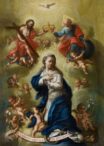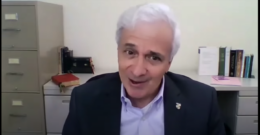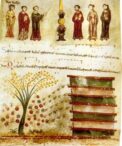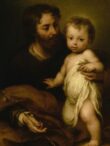In this controversial episode, you’ll learn: -The shocking changes made to the canonization process post-V2 -Which Pope canonized more saints than all other Popes combined -The Pope that presided over the greatest destruction in the history of the Church…and was STILL canonized -Whether miracles need to be real under the new canonization rules And more. You might need a stiff drink for this one.
FOURTH SUNDAY AFTER EASTER: Grace Notes: Why we sing what we sing
We are still running standard fare for Paschaltide: Mass I, Credo I, Vidi Aquam. The Mass was that of the Sunday.
Today was the day of our May procession and crowning. In anticipation of that, we sang, in honor of the King to whom Our Lady owns her queenship, To Jesus Christ Our Sovereign King, as the processional.
Today was remarkable because this is one of the two Sundays on which the longest Offertory antiphon of the year falls. My notes from past years said there was not enough time for an Offertory hymn. I should have believed myself. We delayed Father more than I like as we sang our customary Stella Coeli Extirpavit.
At the Communion, since it is Paschaltide, we sang the exquisitely beautiful hymn, Salve Festa Dies, by the great poet, bishop, composer and Saint, Venantius Fortunatus, whose feast is this week. He also composed the well-known Vexilla Regis.
Immediately after Mass we began our May procession. We took a simple route to the pavilion where Our Lady was crowned. As we left the church, we did Rejoice O Mary Heavenly Queen. This is fitting on several levels. This is very much a hymn for Paschaltide, which season we are still full in. And it is the month of Our Lady. And, we were on our way to crown her. On the way, we sang, Immaculate Mary, and in honor of her Son, the King, we sang Eternal King of Realms. As the lovely little ladies of the chapel brought flowers of the rarest, well, of course, we sang Bring Flowers of the Rarest. We held off on singing the chorus until the last of the girls presented the crown of roses to Father, at which point, we sang, O Mary, we crown Thee… Our Lady thus crowned, we sang the Marian Anthem of Paschaltide, Regina Coeli. We concluded with Hail Holy Queen Enthroned Above.
Welcome to Tradition – Episode 14 – Gregory DiPippo and the 1955 Holy Week Reforms
In this episode, you’ll hear Gregory DiPippo explain why he believes the 1955 reforms to the Holy Week liturgies formed the groundwork for the Novus Ordo reforms that would come 14 years later. We talked about: -The major changes to the liturgy -Anibale Bugnini’s role -Archbishop Lefebvre’s decision to accept the 1955 reforms -The leading role sedevacantists have played in opposing the 1955 reforms And of course, much more. If you want to learn about liturgy, join us!
Welcome to Tradition – Episode 13 – Are Canonizations Infallible?
In this episode, we discuss: -Whether canonizations are infallible -If you are allowed to doubt a canonization -The difference between a ‘saint’ and a ‘canonized saint’ -If you are allowed to pray to Archbishop Marcel Lefebvre This was a great conversation! Please join us.
THE EXULTET: IN PRAISE OF THE PASCHAL CANDLE: Grace Notes: Why we sing what we sing
Adapted from the Catholic Encyclopedia, Wikipedia, and other sources.
The so-called Exultet is arguably one of the most glorious and beautiful of hymns of the liturgy. The Roman Missal gives the title simply as Praeconium Paschale, which translates literally as The Pascal Praise. It is sung by the deacon (or priest) in the liturgy of Holy Saturday, in praise of the paschal candle, which is, of course, a type of Our Lord.
The words of the Praeconium Paschale were not always the same, and so it did not always start with the word Exultet, from which we derive the common name for the hymn. There have been numerous versions. It’s probably safe to say that the version in use today has survived where others did not because of its particular beauty. Given its style, it was probably composed as early as the fifth century.
The Exultet is sung immediately after the Procession of the Paschal Candle and the Lumen Christi. Before it is sung, the priest recites the same prayers that he recites during Mass prior to the chanting of the Gospel, and, as at the Gospel, the faithful stand while it is sung.
It consists of two parts. The first part is an invitation for the faithful to join the priest in invoking the blessing of God so that he may worthily sing the praise of the candle. The tones of this first part are exquisitely beautiful, and very different from what we usually hear during the liturgy. Strictly speaking, it is Ambrosian Chant rather than Gregorian. This first part is similar to the Orate Fratres of the Mass, which is, of course, recited immediately prior to the Preface. The second part is very much like a preface and begins with the same invocations (Sursum Corda etc.).
The language of the Exultet is fairly unique in the liturgy in that it is not so much dogmatic as it is mystical and imaginative. The first lines set the mood for the entire hymn:
Let the angelic choirs of heaven now rejoice; let the divine mysteries give praise; and let the trumpet of salvation sound forth the victory of so great a King.
It goes on to recount the exodus of the Israelites from Egypt, emphasizing the similarity between the pillar of fire and the Paschal Candle, both of which are types of Our Lord. It speaks of the needful sin of Adam, and the happy fault (felix culpa) that merited to have such and so great a Redeemer. It concludes by asking God’s blessings for those present, for the clergy, for the pope, and for the local bishop.
The Exultet praises the Candle as Christ. Not surprisingly, this hymn, so clearly about Christ, has a very beautiful and subtle allusion to the Blessed Mother. It is, on the one hand utterly profound, and on the other hand almost quaint.
Therefore, in this sacred night, receive, O holy Father, the evening sacrifice of this incense, which Holy Church renders to Thee by the hands of Thy ministers in the solemn offering of this wax candle, the work of bees.
Now also we know the praises of this column, which the glowing fire enkindles to the honor of God. Which fire, although divided into parts, suffers no loss from its light being borrowed. For it is nourished by the melting wax, which the mother bee produced for the substance of this precious light.
Any candle used in the liturgy serves as a type of Christ. Liturgical candles, and the Paschal Candle in particular, are, of course, made of the wax of bees. Beeswax burns with a particularly sweet scent, which represents the bonus odor Christi (the sweet odor of Christ). The flame represents the Divinity of Christ. The wick symbolizes Christ’s soul, hidden within His body. The wax body of the candle itself, made from the wax produced by the virginal worker bees using the nectar they have gathered from beautiful and sweet-smelling blossoms, symbolizes Our Lord’s pure body. As the candle burns, it gives us light, but sacrifices its body so that we can see. The bees are thus symbols of the Virgin Mary, from whom Christ took His human body.
This unique and very beautiful hymn is certainly a fitting way to introduce the extraordinarily beautiful liturgy of the Paschal Vigil.
In the image: In Italy, in bygone days, the Exultet was sung from scrolls of parchment, which were gradually unrolled during the singing. These “Exultet Rolls” were elaborately and beautifully illuminated. Nearly all such Exultet Rolls contained pictures of bees.
SAINT JOSEPH THE WORKER: Grace Notes: Why we sing what we sing:
The feast of St. Joseph the Worker is a first-class feast. The Second Sunday after Easter is a second-class feast. Knowing that, you knew to set your Missal for St. Joseph. If you are not one to look at the liturgical calendar, you were caught off balance. (Note that they have calendars for cheap in the bookstore – given that it is May already).
As we were running the propers before Mass, one of the men observed, “This is weird music. It doesn’t sound right.” Well, yes. That is because the feast was instituted in 1955 and the music is “modern”. And not only. This particular singer is new to the game, and still, he picked up on the oddity of the chant, which oddity is actually also criticized by more scholarly types. But never mind. We’re not music critics; we’re just singers in a schola band.
Standard fare for Paschaltide: Mass I, Credo I, Vidi Aquam.
The processional was The Other Version of Jesus Christ is Risen Today. It is the bane of procession-goers all over the English-speaking world because when people see the title, they are expecting the OTHER version.
At the Offertory, Stella Coeli Extirpavit. We are SO over singing that. But we will persist until it is clear that the plague that plagues us is behind us.
At the communion, the mixed choir did Palestrina’s Sicut Cervus. Why isn’t Palestrina canonized?
For the recessional, St. Joseph trumped the typical Easter material with Hail, Holy Joseph, Hail. (For you grammar types, yes, the hymnal does correctly have the comma for direct address.) And again, we sang Sweet Sacrament Divine to get the melody into the ears and heads of the faithful because NEXT WEEK, we are going to call on them to sing it for real.
As an aside, the Greek in scripture refers to St. Joseph and Our Lord as τεκτων – Tekton. That is more correctly understood as a Master Builder, not a fellow making small wooden objects for the ladies of Nazareth. And it is much more fitting of Our Lord as Pantocrator (Greek Παντοκράτωρ) – literally, pretty much able to do everything. I can imagine when someone in Galilee wanted to have a house built, people would say, “Ite ad Joseph. He will fix you up.”
QUASIMODO (LOW) SUNDAY: Grace Notes: Why we sing what we sing
Strictly speaking, Paschaltide is the liturgical season that lasts fifty days, starting with First Vespers of Low Sunday and ending before First Vespers of Trinity Sunday. Liturgically speaking, the 8-day period immediately after Easter and prior to Paschaltide – the Octave of Easter – is distinct from Paschaltide.
For our purposes, we can consider both of these periods as similar because of the musical characteristics that are common to both and that distinguish them from the previous seasons of Septuagesima and Lent, and within Lent, Passiontide, Holy Week and the Triduum.
The most conspicuous aspect of the music during the period after Easter is the return of the Alleluia. There are a number of other very visible differences, but the Alleluia stands out.
The Gloria disappeared at the same time as the Alleluia, way back on Septuagesima Sunday, and it returns fully with the Paschal Vigil. But the Gloria had also put in an appearance on Palm Sunday and again on Holy Thursday – with the organ – and with bells!
The organ also returns at the Paschal Vigil. It had disappeared beginning on the first Sunday of Lent, but it, too, put in a couple of appearances. It was used throughout the Mass on Laetare Sunday, and put in a cameo appearance (to accompany the Gloria) on Holy Thursday.
The Gloria Patri is also back. It had been omitted during Passiontide, but we saw it conspicuously when it concluded the psalms that are sung during the distribution of palms on Palm Sunday.
We sang Mass XVII all during Lent, but we made an exception on Holy Thursday, singing Mass IV. Beginning at the Paschal Vigil, and continuing through and including Pentecost, we sing Mass I (Lux et Origo).
The Alleluia, on the other hand, ceased to be sung on Septuagesima Sunday, and not a trace of it was heard until after the Epistle at the Mass of the Paschal Vigil. It didn’t show up on Laetare Sunday. There was no hint of it either on Palm Sunday, nor on Holy Thursday. It was definitively removed from the liturgy and there were no exceptions. The Alleluia, as an exclamation of pure joy, has no place whatsoever in the liturgy, nor on our lips, during those 63 days from Septuagesima to Easter. But when it returns, it is everywhere! *
At Mass, the typical Gradual and Alleluia are replaced by two Alleluias! Alleluias are inserted in the Introit, and in the Offertory and Communion antiphons.
There is another noteworthy difference in the music after Easter. The Vidi Aquam replaces the Asperges prior to Mass, and the usual invocation (Ostende nobis) and its response conclude with an Alleluia.
Interestingly, the psalm that is sung during the Vidi Aquam is the Confitemini, the same that is sung after the Alleluia makes its first trifold appearance in the Paschal Vigil.
The difference between the music of Lent and that of the period after Easter is remarkable, principally because of the Alleluia, but for many other reasons as well. All of them together help us appreciate the meaning of the Resurrection, and the joys of Easter, in contrast with the meaning of Lent, and the sorrows of the Passion. The musical beauty of the liturgy is nowhere more apparent than it is in the contrast that the liturgy offers us during these two seasons.
This Sunday is known as Quasimodo Sunday as that is the first word of the Introit. It is also called Low Sunday.
We sang Rejoice O Mary, Heavenly Queen for the processional and our now standard Stella Stella Coeli Extirpavit at the Offertory.
At the Communion, we sang the Sequence from Easter Sunday, Victimae Paschali, then O Filii et Filiae. For the recessional the OTHER version of Jesus Christ is Risen Today.
We are planning to sing a new hymn, Sweet Sacrament Divine, at first communions in a few weeks, so after the recessional, the choir sang that so that the congregation will start to learn the melody.
* An interesting side note (pun intended): Those of us in the schola and choir must rehearse for the Easter liturgy, and so, of necessity, in the depths of Holy Week, we find ourselves practicing hymns with the word Alleluia in them. We try not to put our hearts in it though. The liturgical lives of those who sing in the schola and choir are lived about two weeks in advance of what is on the liturgical calendar.
In the image: In Victor Hugo’s novel, Quasimodo, rejected by his parents for his deformities, is abandoned inside Notre Dame Cathedral, at a place where orphans and unwanted children were dropped off.
Monseigneur Claude Frollo finds the child on “Quasimodo Sunday” and “called him Quasimodo; whether it was that he chose thereby to commemorate the day when he had found him, or that he meant to mark by that name how incomplete and imperfectly molded the poor little creature was,” Hugo wrote.
THIRD SUNDAY AFTER EASTER: Grace Notes: Why we sing what we sing
We had something of a collision of ceremonies at our humble chapel this Sunday. Normally, it being the Second Sunday of the Month, the Holy Name Men would make their observances. But we also had first Communions so the Holy Name Men were requested to stand down. And so, we did.
We are still running standard fare for Paschaltide: Mass I, Credo I, Vidi Aquam.
For the processional, we did Immaculate Mary with the Fatima refrain. It’s not that it’s inappropriate. On the contrary, it being the month of Our Lady. We might rather have done an Easter hymn. But we have May procession next week, and the lovely little girls are more familiar with the Lourdes refrain. Unfortunately, the hymn sheets we have already printed have the Fatima refrain, so we wanted the girls to hear the Fatima refrain one time before next week. Yes, sometimes our choices have very practical motives.
At the Offertory, yet again, Stella Coeli Extirpavit. It is well that it is so pretty, else we would tire of it.
At the communion, Adoro Te, and a sop to the Holy Name Men, Jesu Dulcis Memoria.
For the recessional, we sang Sweet Sacrament Divine and it was well sung, our efforts to indoctrinate the faithful having paid off handsomely.
Welcome to Tradition – Episode 12 – The Unpopular truth about the Divine Mercy
If you’ve heard about the Divine Mercy and asked yourself, “What’s going on with that?”, this is the episode for you! If you think you’ve already heard everything there is to be said about this…you’re in for a surprise. Jim did a deep dive on Sister Faustina, the Diary, the painting, the chaplet and the liturgical devotion. This is one episode you will not want to miss.
Welcome to Tradition – Episode 11
In this episode, you’ll learn: -How the Church uses the solar and lunar calendars -Special devotions and customs for your family to practice at home during Eastertide -Which mysteries of the Rosary are proper to each day and each season -Whether you should abstain from meat on a Friday in the octave of Easter -Whether the Easter Vigil (pre-1955 and post-1955) satisfies your Easter Sunday obligation And of course, much more! Join us.









